Loop by Number of Data
Operation name
Loop by Number of Data
Function overview
Repeats processing for the number of input data items.
Records are the loop unit when table model type data (database, Excel, etc.) is input.
Elements directly included in the element that acts as the base point of loop are the loop unit when XML type data is input.
Loop by Number of Data configuration
|
Icon |
Name |
Description |
|---|---|---|

|
Start Loop by Number of Data |
The start of Loop by Number of Data. |

|
End Loop by Number of Data |
The end of Loop by Number of Data. |
Properties
For details on use of variables, refer to Variables.
Basic settings
|
Item name |
Required/Optional |
Use of variables |
Description |
Remarks |
|---|---|---|---|---|
|
Name |
Required |
Not available |
Enter a name to use on the script canvas. |
|
|
Input data |
Required |
Not available |
Select a component on the script canvas. |
|
Required settings
|
Item name |
Required/Optional |
Use of variables |
Description |
Remarks |
|---|---|---|---|---|
|
Number of data in one loop |
Required |
Available |
Enter the number of data items for one loop. |
|
XML data processing
|
Item name |
Required/Optional |
Use of variables |
Description |
Remarks |
|---|---|---|---|---|
|
Separation path |
Optional |
Not available |
Enter the path that acts as the base point of loop. This field can be omitted when the input data is table model type. |
|
Log settings
|
Item name |
Required/Optional |
Use of variables |
Description |
Remarks |
|---|---|---|---|---|
|
Change log settings |
Optional |
Not available |
Select whether or not to temporarily change the log settings of the loop operation.
|
|
|
Output log |
Optional |
Not available |
Select whether or not to output logs.
|
|
|
Log level |
Optional |
Not available |
Select a log level to be set.
|
|
Comment
|
Item name |
Required/Optional |
Use of variables |
Description |
Remarks |
|---|---|---|---|---|
|
Comment |
Optional |
Not available |
You can write a short description of this connector. |
|
Icon-click menu
|
Icon |
Item name |
Description |
Remarks |
|---|---|---|---|

|
Fold/Expand |
Select + or - displayed on the icon. Show/hide icons between Start Loop by Number of Data and End Loop by Number of Data. When folded, only Start Loop by Number of Data is displayed. |
|
Parallel Stream Processing
PSP is supported.
For details on PSP, refer to Parallel Stream Processing.
Available component variables
|
Component variable name |
Description |
Remarks |
|---|---|---|
|
count |
The number of loops is stored. |
|
How to operate Loop by Number of Data
Creation of the Loop by Number of Data operation
Place operations that you want to repeat between Start Loop by Number of Data and End Loop by Number of Data.
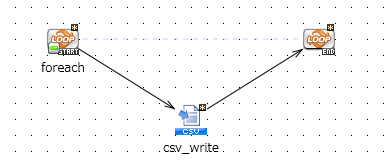
-
If you change the log settings, the log level may change during multi-thread processing, such as PSP or the Thread operation.
-
The range of PSP with Smart Compiler is until the end of the loop operation.
Exception messages
None.
Notes
When Merge Mapper is selected as the input data
The output data of Merge Mapper is always XML type.
Therefore, when the data flow is connected to the Loop by Number of Data operation, it's necessary to specify Separation path as "/table/row" even if output schema is set as table model schema.
When writing operation of a file category connector is placed in the loop operation
When writing operation of a file category connector, such as the writing operation of the CSV connector, is placed in loop operation, the file to be written will be opened/closed at every loop. Therefore, the performance will degrade.
When writing operation of a file category connector is placed in loop operation, the open/close of the file to be written will be eliminated by enclosing the entire loop operation with transaction, and the performance degradation can be prevented.
The following script reads a CSV file and appends the data one by one to another CSV file with loop operation. Though the processing content is the same as a script consisting only of Read CSV File and Write CSV File, the performance will degrade.
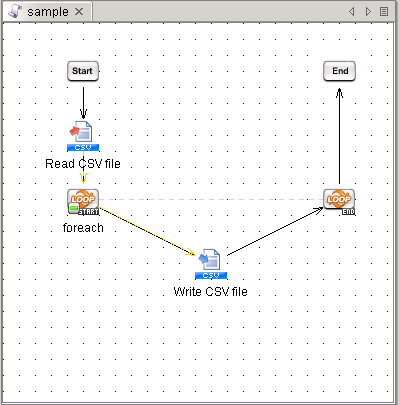
As shown in the following script, the performance degradation can be prevented by enclosing the entire loop operation with transaction.
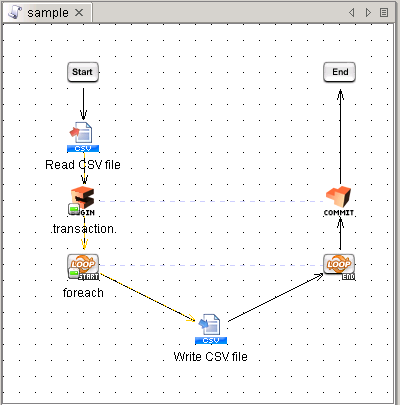
Operation example
Using the Loop by Number of Data operation, create a script to execute the Read CSV File operation and the Write CSV File operation.
-
Create a script as follows.
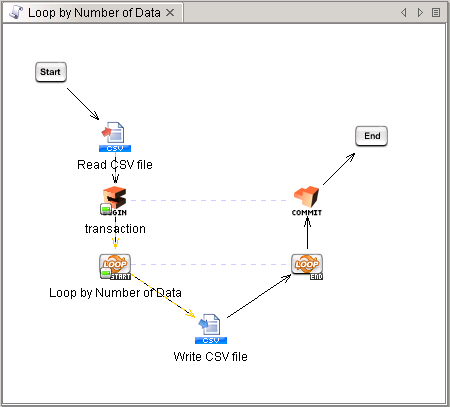
The contents of the CSV file are as follows:
id
value
S001
10000
S002
20000
S003
30000
-
The property settings for the Loop by Number of Data operation are as follows:
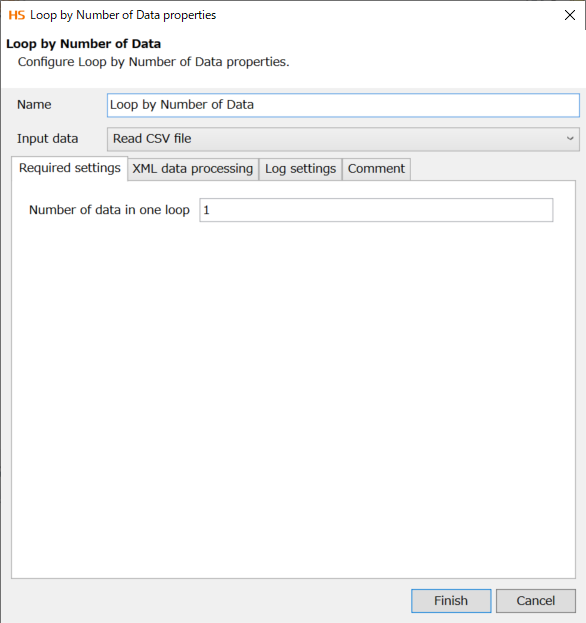
-
Check the result in the execution log view after executing the script.
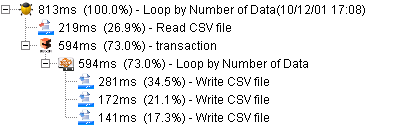
The contents of the CSV file that were written by the Write CSV File operation are as follows:
id
value
S001
10000
S002
20000
S003
30000